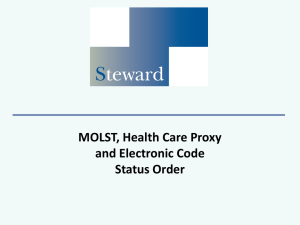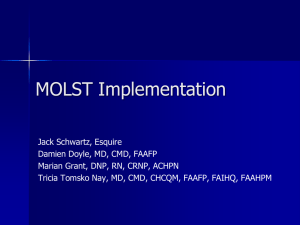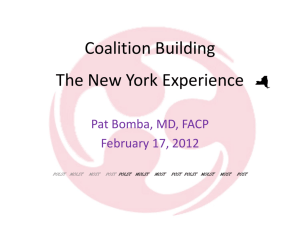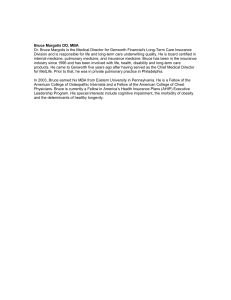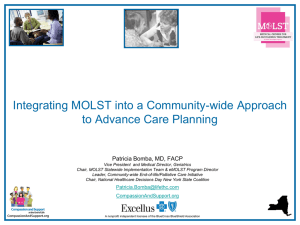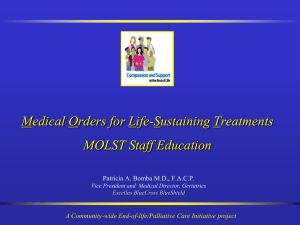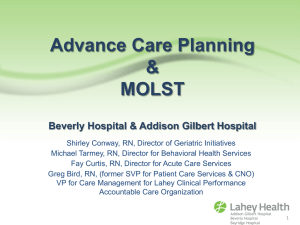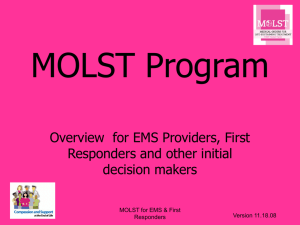Monroe County MOLST Quality Forum Update on MOLST Facility Implementation January 2008
advertisement
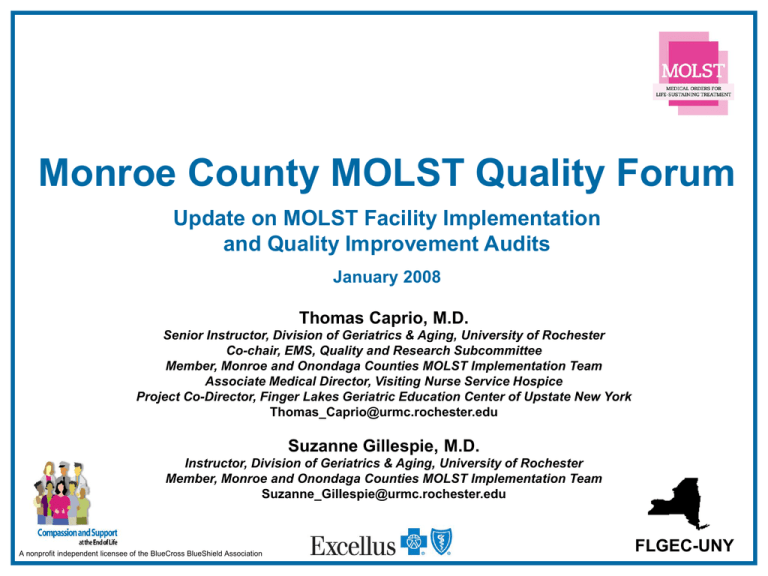
Monroe County MOLST Quality Forum Update on MOLST Facility Implementation and Quality Improvement Audits January 2008 Thomas Caprio, M.D. Senior Instructor, Division of Geriatrics & Aging, University of Rochester Co-chair, EMS, Quality and Research Subcommittee Member, Monroe and Onondaga Counties MOLST Implementation Team Associate Medical Director, Visiting Nurse Service Hospice Project Co-Director, Finger Lakes Geriatric Education Center of Upstate New York Thomas_Caprio@urmc.rochester.edu Suzanne Gillespie, M.D. Instructor, Division of Geriatrics & Aging, University of Rochester Member, Monroe and Onondaga Counties MOLST Implementation Team Suzanne_Gillespie@urmc.rochester.edu A nonprofit independent licensee of the BlueCross BlueShield Association FLGEC-UNY Community Implementation: MOLST Facility Survey MOLST Facility Survey • Early phase: Facility education & training of EMS providers • March 2006: MOLST Facility Survey distributed to 115 facilities in Monroe and Onondaga Counties • Response rate of 98% (n=112) • Time required for implementation varied significantly across facilities, with less adult homes and assisted/enriched living programs planning on adoption of MOLST MOLST Facility Survey • 52 facilities (46%) implemented MOLST • Hospitals and nursing homes first to implement MOLST, followed by hospice programs, and program of all inclusive care of the elderly (PACE) • 76% of respondents had implemented or planning to implement MOLST Total MOLST Survey Response & Implementation Rates Hospital 100.0% 90.0% NH 80.0% PACE 70.0% 60.0% Hospice 50.0% ALP/AH 40.0% 30.0% ALP/EHP 20.0% EHP 10.0% AH 0.0% Response Rate Implementation Rate Total MOLST Implementation: 2 Years Ago - Present Hospital Hospice EHP NH ALP/AH AH PACE ALP/EHP 100.0% 90.0% 80.0% 70.0% 60.0% 50.0% 40.0% 30.0% 20.0% 10.0% 0.0% > 2 Years 1-2 Years 6 Months-1 Year < 6 Months Total MOLST Outlook: Two Years in the Future Hospital Hospice EHP NH ALP/AH AH PACE ALP/EHP 120.0% 100.0% 80.0% 60.0% 40.0% 20.0% 0.0% July 2006 < 3 Months 3-6 Months 6 Months-1 Year 1-2 Years Quality Improvement: MOLST QI Chart Review MOLST QI Chart Review • November 2006 – Facilities in Monroe & Onondaga Counties • Total of 905 medical records reviewed • Majority of chart reviews were completed for patients that died • Facility Participants: 4 Hospitals, 57 Nursing Homes, 2 PACE, 1 Hospice, 24 Enriched and Assisted Housing, 25 Adult Homes 2006 Overall MOLST QI Tool Results: Accuracy Rate for DNR Orders 100% 90% 80% 70% Hospital NH PACE ALP-EHP EHP 60% 50% 40% 30% 20% 10% 0% Monroe County Onondaga County 2006 MOLST QI Tool Results: Accuracy Rate for Life-Sustaining Treatment 100% 90% 80% 70% Hospital NH PACE ALP-EHP EHP AH 60% 50% 40% 30% 20% 10% 0% Monroe County Onondaga County MOLST QI Chart Review • Repeat Facility QI Review 2007 • Preliminary results since December 2007 • Total of 381 medical records reviewed to date in this repeat survey • Participants: Hospital, NH, Pace, EHP • Comparisons to 2006 survey QI Target: DNR/CPR Consent • Patient/HCA Consent for DNR – 100% • Supplemental Documentation present 57% (113/198) for 2007 and 58% (227/389) for 2006 Accuracy of Completion: Documentation Patient or Health Care Agent Consent 100 90 80 70 60 50 40 30 20 10 0 Pt/HCA Consent 2006 2007 Full Code Documentation • Is MOLST being utilized to document full code status? • 7% MOLST document full code in 2006 • 16% MOLST document full code in 2007 Accuracy of Completion: MOLST Signed by Physician 100 90 80 70 60 50 40 30 20 10 0 MD Signature 2006 2007 Other Advance Directives • 2006: 62% Health Care Proxy (448/722) • 2007: 70% Health Care Proxy (238/338) • No advance directives marked 2006: 29% reported 2007: 21% reported Life-Sustaining Treatment • Other Treatment Directives – 2006 None Specified 48% – 2007 None Specified 33% • Comfort-oriented care only: when other instructions identified – 2006 8% – 2007 23% (majority in PACE and nursing home) Life-Sustaining Treatment Other Documented Treatment Guidelines: • Intubation and Ventilation Instructions – 2006 44% – 2007 55% (higher documentation hospital) • Artificial Hydration/Nutrition Directives – 2006 38% – 2007 52% (higher documentation in PACE) Future Hospitalizations Documented Treatment Guidelines: • Hospitalization and Transfer – 2006 13% – 2007 49% (higher documentation in PACE) 2008 QI Targets Identified • Review/Renew section of MOLST • Issues of capacity and consent (Supplemental form completion) • Additional treatment directives
